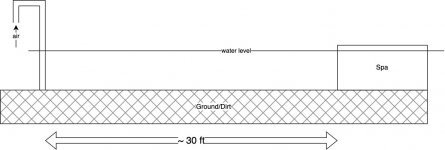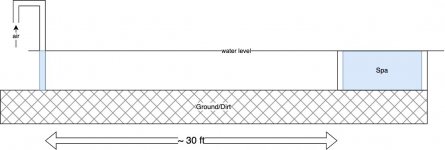My spa doesn’t have a dedicated blower. Instead there seems to be an air intake pipe that emits gargling sounds when I set my system in spa mode. That pipe is near the pool equipment, which is about 30 feet from where the spa is.

When I turn on the spa mode, I hear the pump ramp up, and the valves are moving such that the flow is directed towards the spa. However, the flow seems very weak when I put my hands near any of the spa jets.
If I manually blow in the air pipe, I’m able to “unwedge” the system and bubbles start appearing, with jets coming in at what appears to be full force.
I’ve had 2 pool guys come and try to fix this problem, and they both disregarded my initial analysis and instead decided to follow their “standard debugging flow”, which consisted of first cleaning up the filters, then disassembling all jets to check for blockages… I mentioned to them that I could “prime the system” manually which made these 2 causes not very likely, but that did not change their mind, and about $1,000 later, I’m no better.
My hypothesis is that there is something wrong with the venturi tee that brings in air to mix with the flow of water. I don’t know where this tee is since the air pipe goes “underground” at the equipment area, so the tee could be right there, or somewhere along the way to the spa. I imagine it is close to the equipment because the alternative means the builder would have had to build a long air pipe towards the spa for the mixing to happen near the jets. I think what could be happening is that at rest, the water is coming back up the air pipe to level with the spa’s highest point, and when I turn on the flow, the venturi mixer is unable to flush that extra water from the air pipe for some reason.
I’ve thought about workarounds:
1) add a blower that does what I manually do - I’m reluctant to do that since it used to work 2 years ago without any extra equipment. I don’t like to complicate systems and would prefer to find the root cause.
2) add a check valve in the air pipe to prevent water from coming back up that pipe, so it’ll be easier for the venturi to “prime” the next time around, without having to flush a bunch of water out first
What is my next step? Should I dig down to follow the air pipe and figure out whether I hit the venturi mixer close-by? And if so, is there a test I can run to check whether it is clogged/defective?
Advice much appreciated!
Thanks in advance!

When I turn on the spa mode, I hear the pump ramp up, and the valves are moving such that the flow is directed towards the spa. However, the flow seems very weak when I put my hands near any of the spa jets.
If I manually blow in the air pipe, I’m able to “unwedge” the system and bubbles start appearing, with jets coming in at what appears to be full force.
I’ve had 2 pool guys come and try to fix this problem, and they both disregarded my initial analysis and instead decided to follow their “standard debugging flow”, which consisted of first cleaning up the filters, then disassembling all jets to check for blockages… I mentioned to them that I could “prime the system” manually which made these 2 causes not very likely, but that did not change their mind, and about $1,000 later, I’m no better.
My hypothesis is that there is something wrong with the venturi tee that brings in air to mix with the flow of water. I don’t know where this tee is since the air pipe goes “underground” at the equipment area, so the tee could be right there, or somewhere along the way to the spa. I imagine it is close to the equipment because the alternative means the builder would have had to build a long air pipe towards the spa for the mixing to happen near the jets. I think what could be happening is that at rest, the water is coming back up the air pipe to level with the spa’s highest point, and when I turn on the flow, the venturi mixer is unable to flush that extra water from the air pipe for some reason.
I’ve thought about workarounds:
1) add a blower that does what I manually do - I’m reluctant to do that since it used to work 2 years ago without any extra equipment. I don’t like to complicate systems and would prefer to find the root cause.
2) add a check valve in the air pipe to prevent water from coming back up that pipe, so it’ll be easier for the venturi to “prime” the next time around, without having to flush a bunch of water out first
What is my next step? Should I dig down to follow the air pipe and figure out whether I hit the venturi mixer close-by? And if so, is there a test I can run to check whether it is clogged/defective?
Advice much appreciated!
Thanks in advance!



